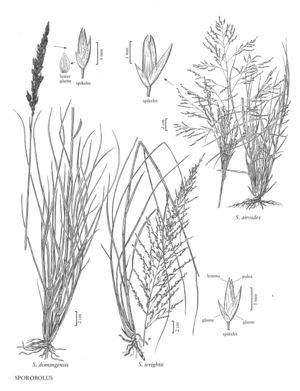Difference between revisions of "Sporobolus airoides"
FNA>Volume Importer |
FNA>Volume Importer |
Revision as of 19:24, 24 September 2019
Plants perennial; cespitose, not rhizomatous. Culms 35-120 (150) cm, stout. Sheaths rounded below, shiny, apices glabrous or sparsely hairy, hairs to 6 mm; ligules 0.1-0.3 mm; blades (3)10-45(60) cm long, (1)2-5(6) mm wide, flat to involute, glabrous abaxially, scabridulous adaxially, margins smooth or scabridulous; flag blades ascending. Panicles (10)15-45 cm long, 15-25 cm wide, diffuse, subpyramidal, often included in the uppermost sheath; primary branches 1.5-13 cm, spreading 30-90° from the rachis; secondary branches spreading, without spikelets on the lower 1/4 - 1/3; pulvini glabrous; pedicels 0.5-2 mm, spreading, glabrous or scabrous. Spikelets 1.3-2.8 mm, purplish or greenish. Glumes unequal, lanceolate to ovate, membranous; lower glumes 0.5-1.8 mm, often without midveins; upper glumes 1.1-2.4(2.8) mm, at least 2/3 as long as the florets; lemmas 1.2-2.5 mm, ovate, membranous, glabrous, acute; paleas 1.1-2.4 mm, ovate, membranous, glabrous; anthers 1.1-1.8 mm, yellowish to purplish. Fruits 1-1.4 mm, ellipsoid, reddish-brown, striate. 2n = 80, 90, 108, 126.
Distribution
Wyo., Colo., N.Mex., Tex., B.C., S.C., Wash., Utah, Calif., Kans., N.Dak., Nebr., Okla., S.Dak., Oreg., Mont., Ark., N.Y., Mo., Ariz., Idaho, Nev.
Discussion
Sporobolus airoides grows on dry, sandy to gravelly flats or slopes, at elevations from 50-2350 m. It is usually associated with alkaline soils. Its range extends into northern Mexico.
Selected References
None.
